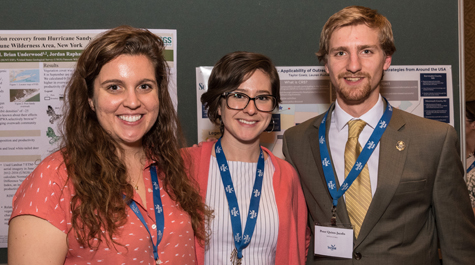Students in Law and Public Policy Aid Virginia's Battle Against Flooding
Virginia Coastal Policy Center Graduate Fellow Joins VIMS & Public Policy Students in Conducting National Research
With the exception of New Orleans, no region in the United States faces as much impending doom from sea-level rise as Hampton Roads, Virginia.
Three William & Mary graduate students in public policy have completed a research project they hope will offer the region a blueprint for protecting their citizens as well as saving them money. Commissioned by Virginia Sea Grant and Wetlands Watch, a Norfolk-based non-profit focused on coastal resiliency, Taylor Goelz, Lauren Pudvah and Peter Quinn-Jacobs prepared reports on 16 communities, from Barnstable, Massachusetts, to Miles City, Montana.
They wanted to know how those communities worked at producing their Community Rating System, which also applies to areas affected by flooding from rivers and other sources.
{{youtube:medium|8FMpSzTWk4U}}
Instituted by the National Flood Insurance Program, CRS incentivizes localities to undertake resilience measures by offering their residents escalating discounts on government-purchased flood insurance based on the amount of local action.
Here’s how it works:
A CRS task force developed a list of community-based floodplain management activities that could be observed and measured. Points were assigned to each activity component. Based on the total score, a community receives a CRS classification. There are 10 classes: Class one requires the most points and gives the largest premium reduction, up to 45 percent.
Residents who buy flood insurance through the government in St. Petersburg, Florida, for example, save about $10 million annually, said Quinn-Jacobs, who also attends William & Mary Law School.
In Virginia, residents who buy government flood insurance policies in Fairfax County, the city of Falls Church, Alexandria and Gloucester County receive a 20-percent policy discount. Norfolk is one of 14 Virginia localities whose residents receive 10-percent discounts.
“The Hampton Roads region is in a unique position where they have to address sea-level rise, and they have to do it now,” Pudvah said.
The three divided the 16 communities, which Goelz said were chosen because they were doing something “interesting for Virginia to look at when contemplating the future and how they want to see their community ratings system program.” They presented their findings to Virginia Sea Grant and Wetlands Watch.
“One problem we found is that there isn’t a lot of connection between programs sometimes,” said Goelz, a dual-degree master’s student at W&M’s Virginia Institute of Marine Science. “You don’t know the cool things your neighbors are doing that might be really applicable to you.”
For example, Ocean City, Maryland, instituted a “transfer rights program” that saved beach dune areas by creating a new zoning ordinance that allowed citizens to buy property technically in the dunes, but those rights transferred to an area in downtown.
“The city didn’t put any money in, but they were able to protect those very valuable beach dunes and open up a lot of open space,” Goelz said.
Barnstable County in Massachusetts hired a fulltime CRS coordinator who runs all of the towns’ CRS paperwork and program implementation.
“It’s really helpful because it’s taken that burden off the localities,” Pudvah said. “They don’t have a lot of time or resources to put into the program.”
Quinn-Jacobs pointed to the abundance of public information offered by Miles City, Montana.
“It was the best one I encountered,” he said. “It’s a great place to look to find out how to get [CRS] points.”
All three were impressed by how many people “were very interested in telling us their stories,” Quinn-Jacobs said.
“There was a really cool environment within the program of people wanting to help other people,” Pudvah added.
About William & Mary Law School
Thomas Jefferson founded William & Mary Law School in 1779 to train leaders for the new nation. Now in its third century, America's oldest law school continues its historic mission of educating citizen lawyers who are prepared both to lead and to serve.
